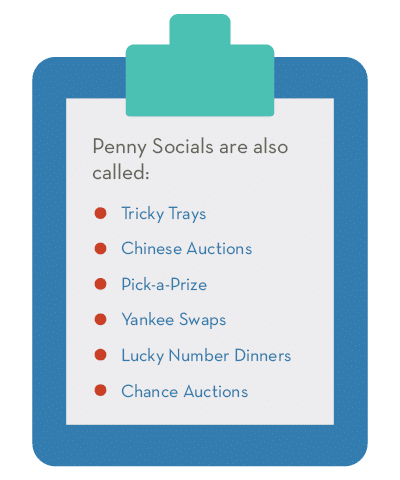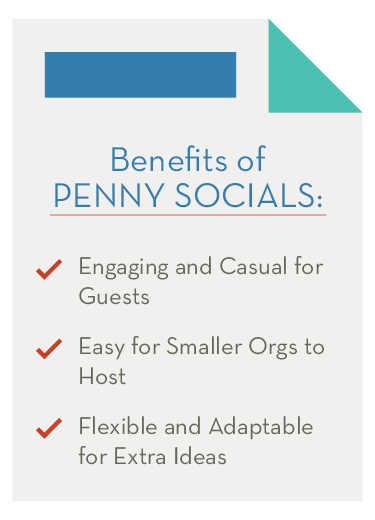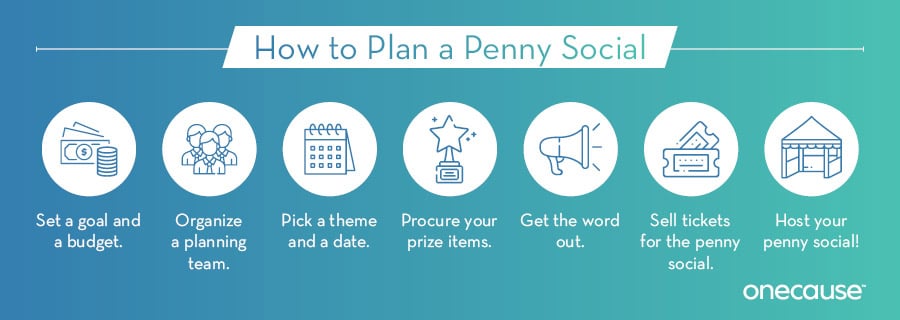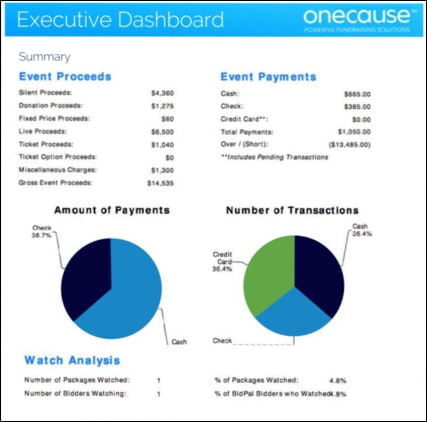What’s a Penny Social? Get More From this Fundraising Event
Whether you call it a penny social or something else (more on that later), you’ve almost certainly heard of these fundraising events before. They’re a staple of the fundraising world, and for good reason.
Penny socials are popular with organizations and donors alike because they’re fun! They offer the experience of a classic charity auction in a more casual format. Plus, they typically don’t require as much investment of time and resources to plan as auction-style events.
A penny social could be the perfect fundraising event for your organization, community group, school, or church. If you’ve never hosted one before, though, it might be tricky knowing how to get started. We’ve got you covered.
Let’s walk through some key topics, steps, and ideas to help launch your penny social:
- Penny Socials: The Basics
- Planning a Penny Social Event
- Selling Penny Social Tickets
- Penny Social Fundraising Ideas
Use the list above to jump to a particular section, or just follow along from the top. You’ll be hosting your penny social in no time!
1. Penny Socials: The Basics
So, what is a penny social?
A penny social is a fundraising event that combines elements of raffles and silent auctions. Guests buy special tickets that they use to bid on items and prizes. Each ticket equals one bid. A winning ticket is drawn at random, and the guest who placed that ticket wins the item.
Who hosts penny socials?
Organizations of all shapes and sizes host penny socials and penny raffle-style events. These often include:
- Nonprofits
- Schools
- Community groups
- Churches or youth groups
Penny socials are great fundraising events for smaller, tight-knit groups or events where you need a quick and easy fundraising idea.
Larger organizations can definitely succeed with penny socials, but the logistics will likely be more complicated. Charity auctions often provide a higher return on investment for large nonprofits than more casual events.
How does a penny social work? What are the rules?
There are 5 main steps to a penny social:
- Participants buy their penny social tickets (or raffle tickets). You can use nonprofit auction software to sell virtual tickets, or you can do this the old-fashioned way if that’s easier for your organization.
- Guests explore your item display, as they would at a silent auction. To place bids, they leave tickets in the baskets placed in front of their favorite items.
- Typically, there are no rules about how many tickets can be placed in a single basket or bowl. Feel free to make your own rules depending on the specifics of your event.
- Once everyone’s “spent” all their tickets, the event emcee will pull a random ticket from each basket and announce the lucky winners.
- Winning guests can either collect their prizes right away or later, depending on what other activities are going on at your event.
Why are they effective fundraising events?
Penny socials are relatively easy-to-plan fundraising events, making the auction experience more doable for smaller organizations and groups.
They’re extremely engaging for guests, who will love exploring the prizes while socializing in a casual environment.
Penny socials are also very easy to adapt with additional fundraising ideas and themes (more on these later). For example, a penny social can be its own standalone event or part of a larger themed dinner. Plus, you have complete flexibility over what items you’ll offer and how you’ll price the raffle tickets.
2. Planning a Penny Social Event
Let’s walk through the main steps of planning your penny social:
Step 1: Set a goal and a budget.
Start by setting a fundraising goal for your penny social. How much do you want or need to raise with this event?
Next, outline a budget. This will likely need to include event planning tools, the venue, supplies (including the penny social tickets), and food and drink. Ideally, all of your prize items will be procured from community donors, but you might need to spend some money on those, as well.
Setting these guidelines now will help keep your whole event planning process on track.
Step 2: Organize a planning team.
The size of your team will depend on the size of your organization, but it’s important to assign responsibilities early. You’ll need these key players:
- Event chair – the leader of the planning team who’ll keep things on track.
- Procurement team – one or more people to solicit prize items from donors and businesses.
- Logistics team – one or more people to handle the venue, invites, promotions, etc.
- Emcee or host – someone to host the event and make sure guests follow the rules.
Don’t forget to recruit extra volunteers as needed to help out on the day of the event, too!
Step 3: Pick a theme and a date.
What will be the theme of your event? Penny socials typically have creative themes to keep guests entertained and engaged all night. We’ll walk through some top theme ideas in Section 4 below.
Now’s also the time to set a date for the penny social. Narrow it down based on venue availability, holidays, and your organization’s own calendar. Try to avoid dates and times when your core audience will be busy with work, travel, or other events.
Once you’ve set a date, outline a timeframe for your planning team. Using event fundraising software can seriously streamline this process.
Step 4: Procure your prize items.
Remember, the items you offer at the penny social are ultimately what will make it a success!
Try to procure one or more big-ticket items from local businesses, like tickets to an event or new tech, plus plenty of smaller items or packages. We’ll cover some of the most popular item ideas in Section 4 below.
Give yourself plenty of time to find the right items, and think about what types of prizes would most interest your audience. For example, a school’s penny social for high-schoolers should feature very different items than at a nonprofit’s event for older donors.
Step 5: Get the word out.
Now it’s time to start promoting your penny social. Build some hype by spreading the word through every possible communication channel. These could include:
- Email messages to supporters
- Social media posts and event pages
- Posters and fliers around town
- Mailed invitations
- Word-of-mouth
For the best results, we recommend creating a simple website for your event. This will give you a dedicated place to direct potential guests, and it can accept payments if you choose to sell penny social tickets online or require early registration.
Step 6: Sell tickets for the penny social.
If you’ve chosen to sell tickets online, you’ve already got a head start on this step. You can even open up pre-bidding with the right auction and online ticketing tools!
If you prefer to handle tickets the old-fashioned way, just make sure to stay organized and plan ahead to prevent any logistical confusion later.
Just make sure that guests can buy their penny social tickets or tokens both before and during the event. If you choose to sell tickets at the event, be sure you have point of sale ticketing tools to make the purchasing, tracking, and collecting easy for your team and volunteers. We’ll cover more in-depth ticketing tips in the next section.
Step 7: Host your penny social!
Finally, it’s time for the main event itself! Give your team plenty of time to set up the venue and prepare other elements of the event. Penny socials themselves typically last about 2 hours.
When setting up your prize items, think about traffic flow. Make sure guests won’t get jammed up around U-shaped setups or overcrowded displays with too much to look at.
Make sure everything’s clearly labeled and that each item has its own basket or bowl to collect tickets. Designate an area for guests to check-in and purchase additional tickets and a booth for guests to check out and collect their items.
Post-Event Best Practices
One crucial step that many organizations overlook is following up with guests after the event.
Send personalized thank-you messages to all guests and item donors. This not only expresses your gratitude (after all, everyone who attended made donations by buying tickets), but it also helps to build stronger relationships for more events down the line.
After your event is also when you should review your performance. Did you meet your goals? Were there any unexpected issues? Did you grow your audience?
Learning from your events is the best way to continually improve them! If you’ve been using dedicated event planning software, it should be easy to track your results and generate new insights.
For example, you can track the bidders who bought the most tickets or the most bid-on items to help you figure out where you could be improving next time around. By the time of next year’s event, you’ll be a penny social pro!
3. Selling Penny Social Tickets
Ticketing is always an important element around planning nonprofit events. How you choose to offer penny social tickets can have an especially big impact, though!
Remember, as stand-ins for monetary bids, the tickets are what drives the fundraising value of the penny social. Start by determining how you’ll sell them.
Ways to Sell Penny Social Tickets
There are a number of ways that you might sell the tickets to guests:
- Go digital. Using event fundraising software or online auction tools will give you flexible ways to engage with guests online before the penny social. Let guests register online and buy ticket packages, or even open up pre-bidding on top items to give excited guests a head start.
- Use traditional tickets. There’s nothing wrong with the old-fashioned technique! Let your guests buy sheets or rolls of tickets at the door on the night of the event. Just make sure you have a plan in place for easily tracking whose tickets are whose so you can identify winners.
- Invest in ticketing tools. iPad-based Point of sale ticketing tools can seriously streamline how your team’s job if you choose to sell tickets at the event. Even when using traditional tickets, it’s a good idea to use digital payment processing tools that can track who bought which tickets.
Your best choice is most likely developing a mixed strategy. Using a combination of traditional and digital methods is a good idea for penny socials since you’ll need to make sure guests will be able to buy bidding tickets both before and during the event. Think about which ticketing options are best suited for your particular audience and event.
Tools You’ll Need
No matter how you choose to sell the tickets, it’s a good idea to invest in some sort of event planning or registration software. Tracking ticket sales and distribution is a logistical challenge, and doing it manually leaves you open to too much risk. Using the appropriate software will streamline the process for both your team and your guests.
If you choose to go more digital than traditional, look for charity auction software. This will give your team plenty of options for how you’ll engage guests and offer tickets online.
For any event that you’ll be promoting heavily, it’s always a good idea to create a dedicated event website. This will give you a specific place to direct supporters to register, buy tickets, or simply learn more.
Of course, any penny social needs rolls of tickets, too. Putting the tickets in baskets or bowls to bid is part of the fun of these events and what helps keep them casual and enjoyable for all kinds of audiences.
Pricing Your Tickets
Think very carefully about how you’ll price the tickets. Consider these elements and try to find the right balance:
- The total cost of the event itself
- Your fundraising goals for the penny social
- The value of the prize items
- What would be reasonable for your audience
Take your time determining ticket prices! Charge too much, and you might drive down the excitement and competition with fewer people willing to buy tickets. Charge too little, and you risk losing money if attendance is lower than expected.
Incentive pricing works especially well for penny socials. Offer a 2- or 3-for-1 type deal on ticket packages. This encourages attendees to purchase more tickets, and more tickets at play during the event means more competition and excitement for everyone.
4. Penny Social Fundraising Ideas
Penny socials are flexible fundraising events for organizations of all sizes. It’s easy to incorporate a variety of creative ideas into your penny social. By fully customizing your event to your goals and audience, you can seriously boost its impact! Here are a few effective ideas for making your penny social a success:
Penny Social Theme Ideas
Try these creative themes to give your penny social an extra element of fun:
- Hawaiian Luau or Day at the Beach
- Decade Nostalgia, like the 60s, 70s, or 80s
- Winter Wonderland, perfect around the holidays
- A Night in Paris, complete with baguettes and accordions
- March Madness or Football Season Kickoff Party
- Chef’s Table, all about cooking and gourmet food

To help pick a theme, think about the calendar and your target audience.
What would they enjoy? How old are most of your supporters? What are their interests? What about your organization brought them all together?
By building your event around your guests, you can help ensure that they’ll be more engaged, meaning they’ll have a great time and you’ll raise even more money.
Penny Social Item Ideas
Just like with other auction-style fundraising events or raffles, the items and prizes you offer in your penny social will play a huge role in its success. Get your guests excited to buy tickets with the perfect items!
We’ve gathered some of the top auction item ideas to help you start brainstorming. Here are a few of our favorites for penny socials:
- Event tickets. Sporting events, concerts, music festivals, and plays are all popular choices. You might need to buy the tickets yourself, but you can easily make up the cost with the right event.
- Technology. Try to procure a top-of-the-line smartphone, laptop, smartwatch, camera, or tablet from a generous local retailer, or see if a donor will cover the cost.
- Food and drink packages. A local restaurant might donate a gift certificate and reservation, or you can build a package of wine and gourmet food products.
- Lessons or personal training. Talk to local trainers about donating their services, or see if a local pro will spend an afternoon sharing pointers. Golf lessons are a great example.
- Experiences. Get creative and offer prizes with unique experiences attached, like food tastings, circus outings, hot air balloon rides, or anything else your audience would enjoy.

- Spa day package
- Food and drink
- Kids’ summer activities
- Cookout supplies
- Book lovers’ basket
Remember to give your team plenty of time to gather the items for your penny social. Review our guide to auction item procurement for a step-by-step of the process.
Marketing and Promotional Ideas
Promoting your penny social is essential. Your organization has most likely hosted other fundraising events in the past, so review your past strategies to get started.
Think about all the different marketing channels you can use – email, print ads, posters, social media, etc. Try a few of these classic event marketing strategies:
- Create a central event website. Even if you’re not offering online ticket sales or pre-bidding tools, an event website is always a good idea.
- Reach out to local newspapers and community websites. This is an easy way to reach your closest audiences who keep up to date on their community.
- Rely on your theme. Use your penny social’s theme to help guide the design of your promotions. This will make them bolder and more memorable.
- Offer special deals. Create unique deals to get people engaged early. The first ten registered guests could get a number of free bidding tickets, for example.
- Make it a dinner party. A catered dinner included with admission or even a potluck-style community meal will perk the ears of more potential guests.
- Create a social media contest. Ask followers to share your event page with a unique hashtag, then pick a random winner to receive free tickets or another prize.
Get creative to make sure your event is seen by as many potential guests as possible. When it comes to penny socials, the more the merrier! High turnout will lead to higher ticket sales, more energy at the event, and more competition for your items and prizes.
Wrapping Up
Penny socials are extremely flexible fundraising events for organizations of all shapes and sizes. With the right tools, theming, items, and marketing strategies, you can’t go wrong!
Keep exploring with some additional resources for more tips on planning and hosting fundraising events:
- 10 Expert Tips to Boost In-person Event Attendance and Fundraising – More fundraisers in the room means more dollars raised! Check out our 10 tips to get donors in the door.
- 3 Ways to Use Your Donor Data For Your Next Auction – Donor data is powerful. Use it to your advantage while planning your next auction!
- School Auctions: Updated Step-by-Step Guide to Your Event – Auctions can be very effective fundraising events for schools when planned properly.




















